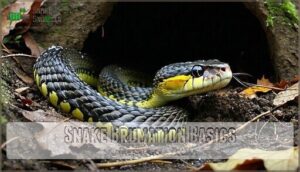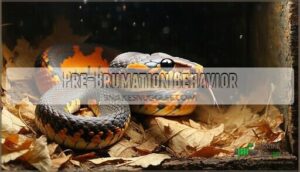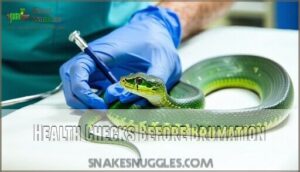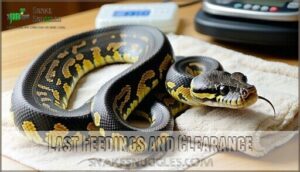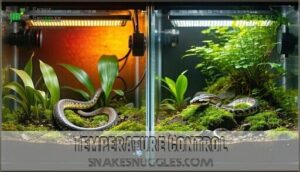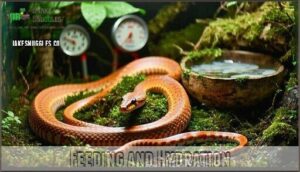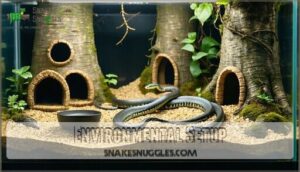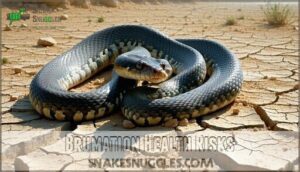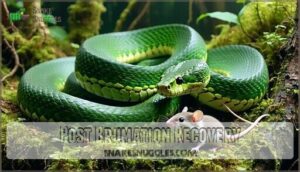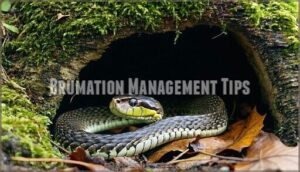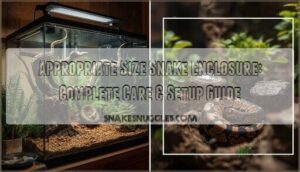This site is supported by our readers. We may earn a commission, at no cost to you, if you purchase through links.
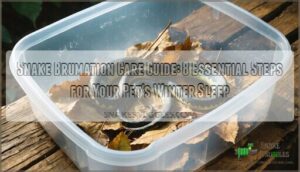 During brumation, your snake enters a hibernation-like state requiring specific care.
During brumation, your snake enters a hibernation-like state requiring specific care.
You’ll need to gradually lower the temperature to 50-60°F while maintaining proper humidity (40-60%). Stop feeding 2-3 weeks before brumation to guarantee your snake’s digestive tract is empty.
Place your snake in a clean, secure container with adequate ventilation and minimal substrate. Check on your pet weekly—they’ll drink occasionally but won’t eat.
This period typically lasts 2-4 months, ending when you slowly increase temperatures. A proper snake brumation care guide considers health checks before and after this critical period.
Wait until you learn when not to brumate—some situations make it dangerous.
Table Of Contents
- Key Takeaways
- Snake Brumation Basics
- Preparing for Brumation
- Brumation Care Techniques
- Brumation Health Risks
- Post Brumation Recovery
- Brumation Management Tips
- Frequently Asked Questions (FAQs)
- How to bring a snake out of brumation?
- How long does snake brumation last?
- Do snakes need water in brumation?
- What should I do during brumation?
- Is brumation normal for snakes?
- Do hognose snakes need brumation?
- How long should hognose snakes brumate?
- Do brumating snakes need water during dormancy?
- Is brumation a normal part of a snake’s annual cycle?
- What to do during snake brumation?
- Conclusion
Key Takeaways
- You’ll need to gradually lower temperatures to 50-60°F before brumation, stop feeding 2-3 weeks prior, and maintain 40-60% humidity levels throughout the dormancy period.
- Your snake will still need fresh water during brumation as they occasionally wake to drink, though they won’t eat until the warming period begins.
- Watch for health risks like dehydration, excessive weight loss (more than 10-15%), and respiratory infections by checking your snake weekly without disturbing them.
- When ending brumation, you should increase temperatures gradually over several days, restore normal lighting conditions, and wait until your snake shows activity before offering a small meal.
Snake Brumation Basics
You’ll need to understand brumation, a natural period of dormancy that helps your snake conserve energy during colder months, before caring for your reptile through this critical process.
Unlike mammalian hibernation, your snake won’t be in deep sleep during brumation and will occasionally wake to drink water, making proper setup and monitoring essential for their health.
Definition of Brumation
Brumation is your snake’s version of winter dormancy—a natural period of inactivity triggered by environmental changes like shorter days and cooler temperatures.
Unlike true hibernation, this reptile brumation process allows your pet to conserve energy while maintaining minimal physiological functions.
The snake brumation experience varies substantially between species, with some barely slowing down while others may appear completely inactive for months.
Even in captivity, this snake dormancy instinct remains strong.
Difference Between Brumation and Hibernation
Unlike mammals, your snake doesn’t truly hibernate. During reptile dormancy (brumation), snakes remain somewhat alert, occasionally drinking water and shifting positions.
Mammalian hibernation involves continuous deep sleep with animals living off fat reserves. Snake brumation allows periodic activity while conserving energy through reduced physiological processes.
The key distinction? Hibernating mammals don’t wake until spring, while brumating reptiles experience intermittent awareness throughout their dormant period. This process is triggered by reduced daylight hours, which leads to a state of reduced physiological processes and allows for periodic activity.
Purpose of Brumation
While hibernation involves deep sleep, brumation serves specific evolutionary purposes for your snake.
- Breeding Stimulation – Increases breeding drive and fertility rates in many species
- Lifespan Extension – Studies show extended lifespans in snakes like Notechis and Crotalus
- Physiological Benefits – Supports natural hormone regulation
- Natural Rhythms – Maintains seasonal cycling important for long-term health
- Overall Health – Snakes often appear reinvigorated post-brumation
Preparing for Brumation
You’ll need to properly prepare your snake for brumation through careful health monitoring and adjusting its feeding schedule.
Before your pet enters this winter dormancy, make certain it’s parasite-free and has completely cleared its digestive tract to prevent potentially fatal complications during this critical period.
Pre-Brumation Behavior
Before your snake enters brumation, you’ll notice several telltale behavior changes.
Watch for a gradual appetite decrease – they’ll refuse meals as their metabolism slows.
Activity reduction becomes apparent as they move less frequently.
You’ll also spot an increase in hiding behavior, irregular shedding patterns, and possible temperament shifts.
These pre-brumation signs typically begin 2-4 weeks before full dormancy, giving you time to adjust their feeding schedule accordingly.
Preparing a Snake for Brumation
Now that you’ve noticed brumation signs, it’s time to prepare your snake properly.
Start the process 4-6 weeks before winter sets in:
- Implement fattening strategies by offering nutrient-rich prey items
- Reduce feeding frequency gradually while monitoring weight
- Create a cooling schedule that drops temperatures 2-3°F weekly
- Provide a dark, quiet enclosure with fresh substrate
- Encourage defecation through warm water soaks
Proper brumation care begins with these preparation steps, ensuring your snake enters this rest period safely.
Health Checks Before Brumation
Before your snake enters its winter slumber, scheduling a veterinary examination is vital for brumation success.
Your vet should perform parasite screening and a thorough physical inspection of your reptile.
Keep tracking weight monitoring during this time, as sudden changes may indicate health issues.
Also, conduct a hydration assessment by checking skin elasticity, which helps guarantee your snake isn’t harboring infections that could worsen during its dormant period, ensuring overall health checks.
Last Feedings and Clearance
The final four weeks before brumation are vital for your snake’s digestive health.
You’ll need to carefully manage pre-brumation diet and clearance.
- Stop feeding mid-October, allowing 2-3 weeks for digestion
- Encourage defecation with warm baths and gentle belly massages
- Monitor weight to confirm proper gut-loading tactics worked
- Schedule a veterinary assessment to check for parasites
Remember, undigested food can rot inside your snake during brumation—better safe than sorry!
This is to prevent potential digestive issues to ensure your snake’s health.
Brumation Care Techniques
You’ll need to maintain precise environmental conditions during your snake’s brumation period, focusing on temperature control, humidity levels, and limited hydration access.
Proper technique includes gradually reducing temperatures to species-appropriate levels (typically 50-60°F) while ensuring a clean enclosure with fresh water that’s checked regularly, even when your pet appears completely dormant.
Temperature Control
Now that your snake is ready for its seasonal slowdown, maintaining proper temperatures becomes your top priority.
Temperature control during brumation directly affects your pet’s health and energy conservation.
| Species Type | Temperature Range | Monitoring Method |
|---|---|---|
| Cold-tolerant | 46-50°F (8-10°C) | Digital thermometer |
| Moderate | 50-60°F (10-15°C) | Thermostat probe |
| Less cold-tolerant | 60-65°F (15-18°C) | Temperature gun |
Implement gradual reduction in thermostat settings over several weeks. Don’t rush this process—your reptile’s metabolism needs time to adjust.
You can find a suitable device online for temperature monitoring.
Humidity Levels
While you’ve got temperature settings dialed in, don’t overlook humidity management during your snake’s brumation period.
Different species have varying requirements—corn snakes do well at 40-60% humidity, while ball pythons need 50-60%.
A good way to maintain humidity is to use a moisture-retentive substrate.
- Too dry? Your snake might develop shedding issues or dehydration
- Too humid? You’re inviting respiratory problems and infections
- North American colubrids prefer drier conditions (20-60%)
- Tropical species often need higher humidity levels
Feeding and Hydration
While maintaining proper humidity, don’t forget that feeding and hydration require special attention during brumation.
Water availability remains critical even as your snake’s appetite decreases.
| Brumation Phase | Feeding Approach | Water Requirements |
|---|---|---|
| Pre-brumation | Gut-loading tactics | Normal access |
| Early brumation | Last meal 2-3 weeks before | Fresh daily |
| Deep brumation | No feeding | Always available |
| Awakening | No food for 1 week | Increased amounts |
| Post-brumation | Small, easy-to-digest meals | Regular monitoring |
Always check hydration signs by pinching skin gently to verify proper snake water intake throughout the process.
Environmental Setup
Creating the ideal brumation environment requires careful attention to details.
Your reptile enclosure should include appropriate substrate choice (newspaper or aspen shavings work well), multiple hiding spots, and consistent water access.
Maintain proper brumation temperature (50-60°F) and brumation humidity levels.
Adjust your lighting schedule gradually to mimic seasonal changes.
It’s important to provide secure reptile shelters for your pet.
Remember, enclosure size matters less than temperature control during this dormant period.
Brumation Health Risks
You’ll need to watch for several health concerns during your snake’s brumation period, including dehydration, weight loss, respiratory infections, and digestive complications that can arise from incomplete digestion.
Even in their dormant state, your reptilian friend requires careful monitoring to guarantee they don’t emerge from winter sleep with potentially life-threatening conditions.
Dehydration
While managing temperature is critical for your snake’s brumation, don’t overlook hydration concerns.
Dehydration remains the #1 risk during this dormancy period. Your snake still needs water even when inactive.
Check for wrinkled skin, sunken eyes, or sticky mucous membranes as warning signs. Always maintain a clean water dish during brumation, and consider increasing humidity slightly to prevent moisture loss during this vulnerable time.
Weight Loss
Even though some weight loss is expected during brumation, excessive drop can signal serious health issues in your snake.
Monitoring weight is essential for successful brumation management.
- 10-15% is generally considered acceptable loss during a 3-month period
- Weekly weighing helps track concerning patterns
- Dehydration often accelerates weight reduction
- Pre-brumation fattening can provide necessary reserves
- Rapid loss exceeding 20% requires immediate veterinary attention
Infections
While weight fluctuations are concerning, infections pose an even greater threat during brumation.
Your snake’s slowed metabolism turns minor health issues into potential disasters.
Respiratory infections often flare up in cooler temperatures, especially when combined with high humidity.
Parasite prevention becomes critical as bacterial infections and fungal diseases progress rapidly when undetected, and communal brumation increases these risks dramatically.
Always consult a reptile veterinarian before winter sleep begins to protect your scaly friend from these serious brumation health risks.
Monitoring Health
Regular health check-ups during brumation can make or break your snake’s winter experience.
You’ll need to monitor weight loss (not exceeding 10% of body mass), check hydration by gently pinching skin, and observe activity levels without disturbing rest periods.
Inspect skin condition weekly for abnormalities and perform fecal examinations when possible.
Snake brumation signs like occasional movement are normal, but lethargy with skin tenting requires immediate veterinary attention.
Ensuring proper environmental temperature control is also essential for their well-being.
Post Brumation Recovery
You’ll need to carefully acclimate your snake back to normal conditions after its winter rest, gradually increasing temperature and monitoring its behavior closely.
When your pet shows signs of activity, you can offer a small meal like a pinkie mouse, ensuring its digestive system has time to reactivate before resuming regular feeding, which is a crucial step in the process of helping your snake readjust to normal conditions.
Gradual Warming
After the dormant brumation period, your snake needs a methodical return to normal temperature conditions.
Implement this gradual warming process correctly:
- Increase photoperiod by 1-2 hours weekly until reaching summer levels
- Raise ambient temperature by 3-5°F every three days
- Restore basking spots after room temperature stabilizes
- Monitor activity levels daily as signs of recovery
- Verify continuous hydration during temperature cycling
This process is crucial for the snake’s health and well-being, and it should be followed carefully to ensure a successful transition.
Resumed Feeding
After the dormancy of brumation, resume feeding with caution.
Offer a small meal (like a pinkie for sub-adults or fuzzy mouse for larger females) 3-5 days after restoring heat.
Your snake’s postbrumation feeding schedule should gradually return to normal as digestion improves.
If your pet refuses food, don’t panic—this isn’t uncommon, and you should monitor closely and try again in a few days with appropriate food type and meal size.
Brumation Management Tips
You’ll need to master several key management techniques to guarantee your snake’s brumation period proceeds safely and naturally.
Managing factors like duration, temperature cycles, and monitoring your reptile’s weight will help you troubleshoot common issues before they become serious problems, ensuring a safe and natural process.
Factors Affecting Duration
Now that your snake is recovering from brumation, you’ll want to understand what influenced its dormant period.
Several factors determine how long your snake will brumate:
- Species Variation – Different snakes have different natural cycles
- Environmental Stability – Temperature and humidity levels affect duration
- Geographic Origin – Snakes from colder regions often brumate longer
- Health Status – Healthier snakes typically have more predictable brumation
- Age Influence – Younger snakes may brumate for shorter periods
Average Brumation Period
While the length of winter dormancy varies by species, most captive snakes will brumate for 2-4 months.
Your snake’s brumation duration depends heavily on several individual factors: younger snakes often brumate for shorter periods than adults, and geographic location influences natural cycles even in captivity.
Species variation plays a significant role too—Western hognoses typically sleep for about 3 months, while Ball Pythons may only need 6-8 weeks of reduced activity.
Ball pythons enter a state of natural dormancy called brumation.
Brumation Frequency
Now that you understand how long brumation lasts, let’s talk about how often it should happen.
In captivity, brumation frequency varies based on several factors:
- Species variation – some snakes naturally brumate annually, while others can skip years
- Captivity impact – controlled environments may reduce natural brumation instincts
- Health implications – only healthy snakes should undergo optional brumation
While annual brumation mimics natural cycles, it’s not always necessary for captive snakes, especially if their behavior shows no signs of seasonal slowdown.
Troubleshooting Common Issues
Five common issues can derail your snake’s brumation.
Watch for signs of dehydration by keeping fresh water available.
If weight loss exceeds 10%, consult your vet immediately.
Prevent respiratory infections by controlling humidity and using fans when needed.
Only healthy snakes should brumate, so schedule pre-brumation check-ups.
Frequently Asked Questions (FAQs)
How to bring a snake out of brumation?
Forsooth, gradually increase temperature to room level first, then restore full heat over two weeks.
Offer fresh water daily, and wait until they’re active before presenting a small meal 1-2 weeks later, which can be considered a small meal.
How long does snake brumation last?
Snake brumation typically lasts 3-4 months, varying by species.
Your reptile might stay dormant from late fall through winter (around December to February/March).
Cold-tolerant species like Black Rat Snakes may brumate longer than others.
Do snakes need water in brumation?
Unlike hibernating mammals, 87% of brumating reptiles still require water.
Yes, you’ll need to provide fresh water during brumation.
Your snake may wake occasionally to drink before returning to its dormant state.
What should I do during brumation?
During brumation, monitor your snake weekly, maintain water access, keep temperatures stable (50-60°F), minimize disturbances, and check for weight loss.
You’ll need to make certain humidity remains appropriate while occasionally offering gentle soaks for hydration.
Is brumation normal for snakes?
Perfectly predictable periods of pausing are part of your snake’s natural cycle.
Yes, brumation is completely normal—it’s your cold-blooded companion’s way of conserving energy during cooler months, just like hibernation in mammals.
Do hognose snakes need brumation?
While not essential for survival, your hognose snake can benefit from brumation.
It’s natural for them in the wild and may improve their health and breeding success if you’re planning to breed them.
How long should hognose snakes brumate?
While some believe all brumation periods are the same, you’ll want to keep your hognose snake in brumation for 2-3 months.
Western hognoses typically brumate December through February, while Eastern varieties need slightly less time.
Do brumating snakes need water during dormancy?
Yes, you’ll need to provide water during brumation.
Unlike hibernating mammals, snakes still require hydration when they periodically wake from their dormant state, though they’ll drink much less than during active periods.
Is brumation a normal part of a snake’s annual cycle?
Brumation is absolutely a normal phase in your snake’s yearly cycle.
It’s their natural response to seasonal changes, where they’ll slow down metabolism and activity during colder months, even in captivity with controlled environments.
What to do during snake brumation?
During brumation, maintain proper temperature (50-60°F), provide fresh water, check weight bi-weekly, make certain minimal disturbances, and watch for signs of illness.
You’ll need patience as your snake remains inactive for weeks or months, and it’s crucial to be vigilant for any signs of illness.
Conclusion
Every reptile keeper worth their salt knows proper brumation is essential.
Mastering this snake brumation care guide will guarantee your pet’s natural cycle happens safely, minimizing health risks while supporting breeding success.
You’ll need patience, attention to detail, and consistent monitoring throughout this process.
When done correctly, brumation benefits your snake’s long-term wellbeing.
Remember, not every situation calls for brumation—always prioritize your reptile’s specific needs and consult a veterinarian with concerns.
- https://www.reptifiles.com/heterodon-hognose-snake-care/hognose-snake-health/internal-parasites/
- https://reptifiles.com/corn-snake-care-guide/corn-snake-temperatures-humidity/
- https://www.norcalherp.com/uploads/8/0/8/3/80835988/online_version_ballpython_2.pdf
- https://www.zenhabitats.com/blogs/reptile-care-sheets-resources/all-about-reptile-brumation-everything-you-need-to-know?srsltid=AfmBOopr__lyIXimFiMjGiJI7Dth_Ya0LHE0ZqVrrODfjqfYbK9o74fP
- https://dandavisreptiles.weebly.com/brumation.html

